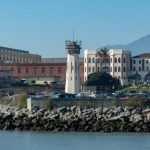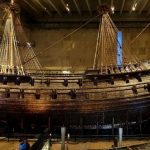 Movies and TV
Movies and TV  Movies and TV
Movies and TV  Food
Food The Fantastic Chemistry Behind Why 10 Popular Foods Taste So Good
 Technology
Technology 10 Futuristic Fungal Technologies
 History
History 10 Not-so-Spooky Events That Also Happened on October 31
 Creepy
Creepy 10 Unsettling Ghost Stories to Tell This Halloween
 Crime
Crime 10 Truly Evil People Who Used Halloween as the Perfect Cover
 Movies and TV
Movies and TV 10 Wildly Different Movie Takes on Nuclear War
 Creepy
Creepy 10 Places Where Folklore Is Alive and Well
 History
History 10 Events That Unexpectedly Changed American Life
 Pop Culture
Pop Culture 10 Cases of Grabbing Defeat from the Jaws of Victory
 Movies and TV
Movies and TV 10 Fictional Kings Who Go from Good to Bad
 Food
Food The Fantastic Chemistry Behind Why 10 Popular Foods Taste So Good
 Technology
Technology 10 Futuristic Fungal Technologies
Who's Behind Listverse?

Jamie Frater
Head Editor
Jamie founded Listverse due to an insatiable desire to share fascinating, obscure, and bizarre facts. He has been a guest speaker on numerous national radio and television stations and is a five time published author.
More About Us History
History 10 Not-so-Spooky Events That Also Happened on October 31
 Creepy
Creepy 10 Unsettling Ghost Stories to Tell This Halloween
 Crime
Crime 10 Truly Evil People Who Used Halloween as the Perfect Cover
 Movies and TV
Movies and TV 10 Wildly Different Movie Takes on Nuclear War
 Creepy
Creepy 10 Places Where Folklore Is Alive and Well
 History
History 10 Events That Unexpectedly Changed American Life
 Pop Culture
Pop Culture 10 Cases of Grabbing Defeat from the Jaws of Victory
10 True Tales of British Women Transported to Australia in Convict Ships
Between 1788 and 1869, around 164,000 convicted criminals were packed off to Australia under the terms of the British Government’s Transportation Act. Something like 25,000 of those who made the enforced journey to Australia were women. For those women, the grueling six-month voyage in dismal conditions was the prelude to a future they could only guess at. These ten tales describe the lives, sometimes dramatic, sometimes tragic, of some of those true pioneers of modern Australia.
Related: 10 Bold Escapes from Island Prisons
10 Mary Broad
Born or, more accurately, baptized in 1765 in the southwestern English county of Cornwall, Mary Broad’s father was apparently a well-known sheep stealer. That may go some way to explain the predicament she found herself in at the Exeter Assizes in 1786, where she was charged with assault and robbery. Her guilty verdict drew the death penalty, commuted to seven yearsof transportation. During her voyage to Botany Bay, Mary gave birth to a girl, and on arrival in Australia, she married fellow convict William Bryant, taking his name.
Bryant was an experienced fisherman and sailor, and in 1791, he and Mary, plus their by now two children, made good their escape aboard a stolen cutter. After 69 days and 3,254 miles (5,237 km), they landed on Indonesia’s Timor Island. There, they were recaptured by a Royal Navy vessel and taken to Batavia, where Mary’s younger child and her husband both died. After further trials and tribulations, Mary ended up in England, where a press campaign for clemency secured a pardon for her in 1793.[1]
9 Margaret Catchpole
Margaret Catchpole was born in 1762 in southern England; her father was an agricultural worker. After spending her childhood on various farms, she became adept with horses. She went on to work as a servant for the Cobbold family but stole one of their horses, riding the 70 miles (113 km) to London. Apprehended, she was sentenced to death for horse theft at the Suffolk Summer Assizes, and her sentence was commuted to seven years of transportation.
But Margaret escaped from Ipswich prison, clambering over the 22-foot (6.7-meter) wall with the aid of a clothesline. But she was soon recaptured in a dramatic scene in which her lover William Laud was shot and killed. Margaret arrived in Sydney in 1801 and found work there as a cook, graduating to become a trusted servant for a wealthy family.
Pardoned in 1814, she elected to stay in Australia, established a shop, and worked as a midwife until her death in 1819. Unlike many convicts, Margaret was literate and left behind a rich trove of letters describing life in colonial Australia.[2]
8 Mary Haydock/Reiby
Mary Haydock was just 13 years old and pretending to be a boy called James Burrow when she was arrested for horse theft in 1790. With her true identity revealed, she was convicted at a court in the town of Stafford and sentenced to transportation. Packed aboard the Royal Admiral, Haydock arrived in New South Wales on Australia’s east coast in 1792, marrying Sydney Reiby a couple of years later. Not a convict, he worked for the East India Company.
Mr. Reiby became a successful trader, but he died in 1811. Mary took over her husband’s business, running its affairs with so firm a hand that she was convicted of assaulting a man who owed her money. She eventually sold her trading business and increased her wealth by investing in property. Mary also took on the role of an upstanding pillar of Australian society, filling her time with good works. She’d come a very long way from her horse-stealing days. She lived on until 1855.[3]
7 Mary Wade
Mary Wade had the unenviable distinction of being the youngest ever to be transported to Australia when she was aged just 11 in 1789. She’d actually earned a death sentence for stealing clothes from another child, but this was commuted. After landing in Sydney, she was parceled off to tiny Norfolk Island, an Australian possession in the Pacific about 1,000 miles (1,609 km) from the mainland. She bore two children on Norfolk and, returning to Sydney, had another by one Teague Harrigan, who disappeared on a whaling expedition.
She then partnered with Jonathan Brooker, eventually ending up as the mother of an extravagant 21 children. After being granted a certificate of freedom in 1812, she eventually married Brooker in 1817. The couple hit hard times when a fire destroyed their property and Jonathan’s furniture-making business. But they recovered to become reasonably prosperous, and Mary lived on to the age of 82. It’s said that today, her descendants in Australia number many, many thousands. Hardly surprising considering those 21 offspring.[4]
6 Esther Abrahams
Esther Adams was apprehended in the act of stealing 24 yards (22 meters) of black lace from a shop in London’s Piccadilly district in 1786. The disgrace must have been hard to bear since she apparently came from a respectable Anglo-Jewish family. But her middle-class background didn’t save her from a seven-year transportation sentence. As she awaited her voyage in Newgate Prison, she bore a daughter, Rosanna.
Perhaps Esther’s background helped, but whatever the case, not long after she arrived in Sydney in 1788, she became the lover of a Scottish Marine officer who’d traveled on her ship, Lieutenant George Johnston. He became a wealthy man in the colony, farming some 4,000 acres (1,618 hectares), and the couple had seven children to add to Esther’s Newgate-born daughter. The two finally married in 1814, and Esther inherited Johnston’s considerable estate when he died in 1823. She lived until 1846, dying at the age of 75.[5]
5 Maria Risley/Lord
Convicted of burglary, Maria Risley was sentenced to seven years of transportation in 1802 while in her early 20s. She reached Sydney in 1804 and was assigned as a convict servant to a Marine officer called Edward Lord. She gave birth to a daughter in 1805, whom she named Caroline Maria Lord. Maria married Lord in 1808, not long after she’d been granted a free pardon and bore him five more children.
Maria had set up a shop while still a convict servant, and she continued to develop her retail venture while her husband became a substantial landowner. Her brother John Risley arrived in Australia in 1819 and joined his sister in the business. The enterprise went from strength to strength, incorporating hotels and lucrative monopolies in meat and wheat. But she fell out with her husband in 1823, who alleged that she was unfaithful. Maria maintained her business career on a lesser scale until her death in 1859.[6]
4 Molly Jones/Morgan
Molly Jones was born in 1762 in rural England, where her father, David, was described as a “laborer and ratcatcher.” Molly married a wheelwright called William Morgan in 1785 but got into hot water four years later when she was charged with stealing “hempen yarn from a bleaching factory.” Found guilty, her sentence was seven years of transportation, and she arrived at Botany Bay in 1790. Her husband, clearly a faithful sort, joined her in Australia, and the pair opened a shop.
Molly obviously had an adventurous streak, escaping her transportation sentence aboard a ship bound for England in 1794. There, she found work as a dressmaker in Plymouth and the time for a bigamous marriage with one Thomas Mears. When their house burned to the ground, Mears accused Molly of arson, and she was sentenced to transportation for a second time. Back in Australia, she made a living as a farmer and married again. She became wealthy and gave money for the founding of a school, finally giving up the ghost in 1835.[7]
3 Hannah Rigby
Born in the northern English county of Lancashire in 1794, Hannah Rigby found herself on the wrong side of the law when she was convicted of larceny in 1821. Her crime drew a sentence of seven years of transportation, and she arrived in Australia a couple of years later. There, Hannah soon got into trouble for running away from her employment as a servant and was confined to the Female Factory for three months.
Even so, and despite more trouble for theft, Rigby was granted her freedom certificate in 1828. But just a couple of years later, she was again convicted for stealing and was sentenced to seven years at the Moreton Bay penal colony. After serving her sentence, she returned to Sidney, where she received a second certificate of freedom. But just three months later, she was back in court for stealing two hats and was sent again to Moreton Bay. This unfortunate woman, who died in 1853, just couldn’t stay out of trouble.[8]
2 Ellen Redchester
Born in about 1764, Ellen Redchester was tried and found guilty of stealing various pieces of fabric in 1878. She was convicted with her husband, William Fraser, and the pair were sentenced to the usual seven years of transportation. The two traveled on one of the ships of the First Fleet, so-called because it was the first squadron that took convicts to Australia.
Ellen gave birth to two children by Fraser, but as a heavy drinker, he died while she was pregnant with the second in 1791. Granted 40 acres (16 hectares) of land, she now took up with one William Morgan, a neighboring farmer. Despite an argument about some pigs Ellen claimed Morgan had stolen from her, the couple had five children. Eventually, the relationship ended, and Ellen went on to marry again. In her later years, she called herself Eleanor Morgan, and she died at the age of 76 in 1840.[9]
1 Frances Williams
In 2011, the Welsh newspaper The Leader claimed that Frances Williams, born in about 1760, was the very first Welsh person to settle in Australia, albeit involuntarily. She went there as a convict to serve seven years of transportation, a sentence that had been commuted from death. In 1783, she’d broken into the home of someone she’d previously worked for and made off with various items, including petticoats, a silk hat, and a blue cloak.
Williams set sail for Australia from Portsmouth in 1787 on board the Prince of Wales, one of the ships of the First Fleet. A fellow passenger on the voyage was a Marine called Robert Ryan, and the two started a romance that resulted in the birth of a daughter. The relationship didn’t last, and Frances went on to have two children with two other men, both convicts. In a strange twist, she had a fourth child in 1796, fathered again by Ryan. Williams died in 1801 on Norfolk Island, leaving her children in the care of foster parents.[10]








